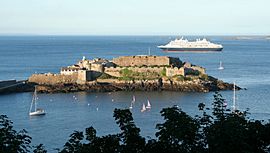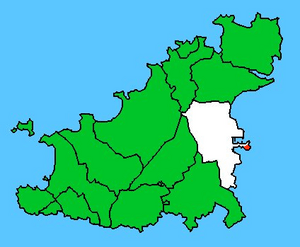Castle Cornet facts for kids
Quick facts for kids Castle Cornet |
|
|---|---|
| Part of Guernsey, Channel Islands | |
| Saint Peter Port Harbour, Saint Peter Port | |

Castle Cornet stands on the former tidal island of Little Roussel.
|
|

Location of Cornet Rock (red) within Saint Peter Port (white)
|
|
| Type | Norman castle with keep |
| Height | Up to 13 metres (43 ft) |
| Site information | |
| Owner | Bailiwick of Guernsey |
| Open to the public |
Yes |
| Condition | Partially restored |
| Site history | |
| Built | c. 1206–1256 |
| In use | Until mid 19th century |
| Materials | Diorite Ashlar Mortar Timber |
| Battles/wars | French Invasion of 1338 English Civil War |
| Events | Hundred Years' War Napoleonic Wars German Occupation of Guernsey |
Castle Cornet is a big island castle in Guernsey. It used to be a tidal island, meaning it was connected to the main island at low tide. People also called it Cornet Rock or Castle Rock. This castle was super important for defending Guernsey and its main harbor, St Peter Port. In 1859, it became part of the harbor's protective walls.
Contents
Where is Castle Cornet?
The island where the castle sits is about 2 hectares (4.9 acres) (that's like 5 acres) in size. It is about 175 metres (574 ft) long and 130 metres (430 ft) wide. The castle is located less than 600 metres (2,000 ft) east of Guernsey's coast.
A Look Back: Castle Cornet's History
Castle Cornet was first built as a fort between 1206 and 1256. This happened after the Duchy of Normandy split up in 1204. At that time, it had a main tower (called a keep), a chapel, two courtyards, and strong outer walls.
Early Battles and Changes
In 1338, French forces attacked Guernsey and captured the castle. They defeated the soldiers defending it. But the islanders fought back and took the castle again in 1340. The French had made the castle stronger during their time there. In 1358, the French captured it again, but they were kicked out the next year.
In 1372, a Welsh leader named Owain Lawgoch attacked Guernsey. He killed many island fighters but could not capture Castle Cornet. He found the castle too strong and well-equipped with cannons. The French tried again in 1380 and briefly took the castle before being forced out. Around 1435, the Carey tower was added to the castle.
As cannons and gunpowder became common, the castle was updated between 1545 and 1548. In 1547, the French attacked Guernsey again. Castle Cornet fired its cannons, helping to defend St Peter Port. More building work happened, and in 1594, the "Royal Battery" was finished. This was a new section for cannons.
In 1627, King Charles I made a deal with Guernsey. The island would provide food and supplies for the castle, and in return, the Crown would pay less for its upkeep.
The English Civil War
During the English Civil War (1642–1651), Castle Cornet supported the King (the Royalists). However, the rest of Guernsey supported the Parliament (the Parliamentarians). The castle closed its gates on March 14, 1642.
For nine years, the castle fired its cannons at the town of St Peter Port. It damaged many buildings. Some island leaders were captured and held in the castle. They managed to escape by making a rope from flax and climbing out of a tower at low tide.
In 1651, Parliamentarian forces took the nearby island of Jersey. A soldier from Guernsey, Ensign Nicholas Robert, found the Crown of England there. It had belonged to King Charles I. He brought it back to Guernsey and gave it to the Governor of Castle Cornet.
The castle was one of the last Royalist strongholds to surrender in the British Isles. It finally gave up on December 17, 1651. The soldiers were allowed to leave with their weapons. The royal Crown was sent back to London.
Later Years and a Big Explosion
After the war, a Parliamentarian leader named Colonel John Lambert was held prisoner in the castle from 1662 to 1670.
Castle Cornet was also where the governor of Guernsey lived. But on December 30, 1672, disaster struck! Lightning hit the castle's gunpowder storage. The explosion destroyed the main tower and many living areas. The governor's mother, wife, and several staff members were killed. After this, the governor moved to live on the main island. The destroyed tower was never rebuilt.
The castle was improved again during the Napoleonic Wars with new barracks for soldiers. It stopped being the island's only prison in 1811 when a new prison was built. After the war, the castle became part of the breakwater (a wall protecting the harbor).
In 1887, a pond for toy boats was built along the breakwater to celebrate Queen Victoria's Golden Jubilee.
Castle Cornet was used as a prison until the end of World War II. During the war, German soldiers occupied the castle. They called it Hafenschloss ("Harbour Castle") and added concrete changes for modern defense. After the war, in 1947, the British Crown gave the castle to the people of Guernsey. This was a thank you for their loyalty during the two world wars.
What Castle Cornet Looks Like
Castle Cornet was built over 800 years, so it doesn't have a simple, planned layout.
To reach the top, you have to go through six different gates!
Main Gate and Outer Ward
The main gate is hidden from cannon fire coming from the island. Above the gate, you can see the coat of arms of Queen Elizabeth I. Inside the main gate, you enter the Outer Ward. Here you'll find an 18th-century barracks and a 19th-century guard room.
The Barbican and Citadel
Next is the Barbican, which is the oldest part of the medieval castle, from the mid-13th century. It has arches that allowed defenders to drop things like missiles or liquids on attackers below. There's another gate and a drawbridge that was the original entrance to the 13th-century castle.
The Citadel is at the very top. It has more gates and defenses, including some built by the Germans during their occupation (1940-1945). This area used to have the round tower that was destroyed in the 1672 explosion. Today, you can see the medieval Tour Carré and the Gunners Tower. The Sutler's House is the oldest house in the castle, as it survived the explosion. The Royal Battery, built around 1575, is in the north-east corner. This is where the noon cannon is fired every day!
Castle Cornet Today
Castle Cornet is a museum itself, showing its 800-year history. It also has four other museums inside:
- The Story of Castle Cornet
- Maritime Museum
- 201 Squadron RAF Museum
- Royal Guernsey Militia Museum – with items from the Royal Guernsey Light Infantry
Every day, except for a few months in winter, a cannon is fired at noon.
You can also find a restaurant, four historical gardens, and guided tours. In the summer, the castle even hosts outdoor theater shows.
Protecting Castle Cornet
The entire Castle Cornet and the small island it stands on became a Protected Monument on March 26, 1938.
Gallery
See Also
- Royal Guernsey Militia
- Royal Guernsey Light Infantry
- History of Guernsey




